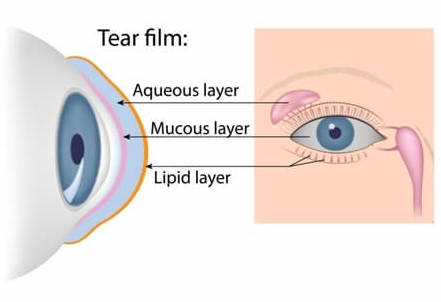It’s common knowledge that staring at electronic screens for long periods can harm your eyes. It’s common for your eyes to feel too dry or have watery eyes sometimes; some of that can be due to spending time in front of screens.
But several other things can also cause dry eyes, and screen time may only be an exacerbating factor. Dry eyes can even be a chronic condition that requires professional treatment. Keep reading to discover if your dry eyes could be connected to too much screen time!
What are Dry Eyes?

If your eyes are burning, stinging, itching, and gritty, it could be because they are too dry and lack sufficient moisture. Dry eyes can also cause excessive tearing, mucus secretion, blurry vision, and light sensitivity.
These symptoms are usually the result of an issue with tear production, tear distribution, or both. Your eyes constantly produce tears that disperse over the surface of your eye to keep it clean and healthy.
Certain factors can affect tear production and distribution. These factors may be environmental and include dry weather, dehydration, and improper contact lens use. They can even include spending too much time looking at screens or using digital devices.
How Screens and Digital Devices Affect Your Eyes
The most significant concern most people talk about with screens is blue light exposure. Blue light has been linked to symptoms like eye strain, fatigue, and headaches.
To minimize some of these issues, you can wear glasses with a special coating that protects against blue light or use a warm light filter on your phone or computer. But you should know there’s no evidence that blue light directly causes dry eyes.
However, people who use screens often can develop dry eyes due to eye strain and infrequent blinking. You tend to blink less when you look at a screen too long.
Blinking distributes a new tear film over your eyes, so if you aren’t blinking enough, your eyes can get too dry, causing irritation. Blue-light glasses and warm-light mode may help with some problems caused by screens.
However, they won’t help you blink more, so they won’t help your eyes from becoming too dry. Fortunately, there are ways to change your screen use that can help with dry eyes.
Adjusting Your Screen Time

In today’s modern world, asking people to stop using screens or digital devices is unrealistic. Phone and computer use have become essential for daily life.
Many people also have jobs requiring them to sit in front of a screen most of the day. But you don’t need to quit your job or forgo modern technology to adjust your screen time.
You should try to use screens and devices less when possible. Limiting your time in front of the TV or on your phone can help keep your eyes from feeling too dry.
But if you can’t avoid spending extended time looking at a screen, use the 20-20-20 rule. This rule helps balance out the adverse effects of screen use and gives your eyes a break.
The 20-20-20 rule states that you should take a break from looking at screens every twenty minutes. The break should be at least twenty seconds long, and you should look at an object twenty feet away.
Spending even twenty seconds looking at something else allows your eyes to readjust their focus and reduce strain. It also reminds you to blink.
Take the time to use eye drops or artificial tears if your eyes feel dry, itchy, or irritated. You can also practice blinking more when you’re looking at screens.
Good screen-use habits can help prevent dry eyes and reduce irritation. However, the root cause of dry eyes may be a chronic condition rather than just not blinking enough.
What is Dry Eye Syndrome?
Chronically dry eyes, also known as dry eye syndrome, is a common medical condition. It’s most common in older patients and women, especially women going through menopause.
It’s also often linked with skin conditions like rosacea and blepharitis. But it can affect anyone of any age, gender, or medical history.
While the root cause of dry eye syndrome varies, it’s usually due to an issue with tear production. Patients with dry eye syndrome typically produce tears that lack sufficient nutrients or don’t produce enough tears.
Your tears have three components that comprise the three tear layers. The inner layer is mucus, the middle layer is water, and the outer layer is oil.
When you have dry eye syndrome, there’s usually not enough of one of these components; if any of them is missing, it throws the tear film out of balance. One common issue with tear production is with the oil layer.
The meibomian glands, which produce the oil for your tears, can become inflamed and dysfunctional. When this happens, less oil is produced, resulting in your tears evaporating too quickly because they don’t have enough oil protecting them from the air.
Regardless of what causes dry eye syndrome, factors like too much screen time can exacerbate it. But changing how you use screens will not fully treat the issue, even if it may improve your symptoms.
Dry Eye Treatment

The ophthalmologists at St. Luke’s Eye recommend that patients start dry eye treatment with simple lifestyle changes and home remedies. In addition to adjusting your screen time, you can take omega-3 nutritional supplements, use a wet compress over the eyelids to reduce inflammation, use a humidifier at your home or office, and stay hydrated.
But if you have dry eye syndrome, these changes may only reduce symptoms and not eliminate them. In such cases, we recommend professional treatment.
St. Luke’s Eye offers several minimally invasive in-office dry eye treatments, including amniotic membrane treatments, LipiFlow, and punctal plugs. Are you ready to get to the bottom of what’s causing your dry eyes? Learn more by requesting an appointment at St. Luke’s Eye in Clearwater, FL!








